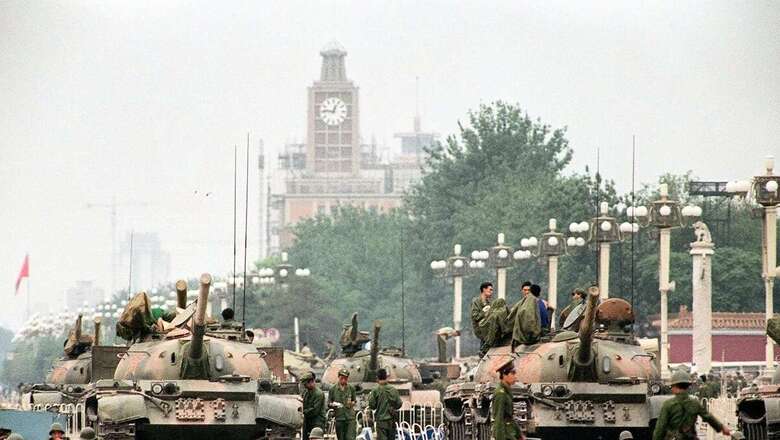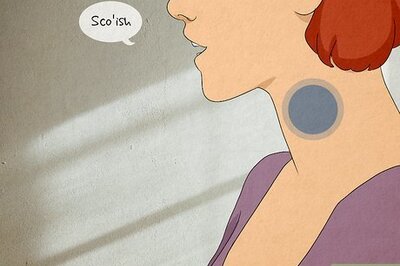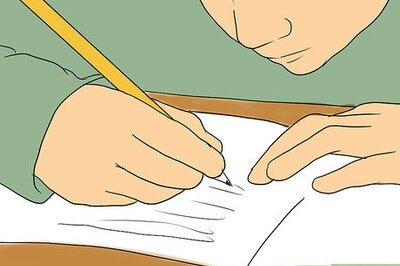
views
June 4 marks the 35th year of the Tiananmen Square massacre in China. This fateful event changed the socio-political landscape of the country forever whose consequences are borne by Chinese people even today. While Beijing has completely censored (and continues till today) any reference to China’s Tiananmen Square massacre within the country, it is important to revisit June 4, 1989.
The Tiananmen Square massacre happened at a time when China was going through a period of relative freedom. In the 1980s, China witnessed Deng Xiaoping’s economic reforms. Besides, he was also aiming for military reforms via the modernisation of the People’s Liberation Army (PLA) in order to establish more political control over the military. The reforms ushered in hopes of greater political freedom and transparency among the Chinese population. However, in reality, China was engulfed with increasing cases of high-level government corruption.
The triggering point was the death of Hu Yaobang, a former party leader of the Chinese Communist Party (CCP). Known to be a champion of liberalisation, Yaobang was deposed from his position in 1987 by the hardliners in the CCP who advocated for strong state control. Yaobang’s death led to protests started by about 600 students and teachers who gathered at Tiananmen Square on April 15, 1989 – one of Beijing’s famous landmarks, considered to be the symbolic centre of political power in China. The number of protesters swelled to 1.2 million within weeks as people joined in sit-in demonstrations and hunger strikes at Tiananmen Square, demanding economic reforms, political freedom, transparency and an end to corruption.
The grassroots, student-led, pro-democracy protest at Tiananmen Square brought divisions among the CCP leaders with respect to response to the protest. While reformists within the CCP voiced against any militarised action and favoured a more conciliatory approach, elder party leaders like Deng Xiaoping supported the imposition of martial law, perceiving the protest as a direct challenge to the CCP’s legitimacy.
The People’s Daily on April 26, 1989, weeks before the massacre, even hinted at the requirement of a possible military action targeting the students. In fact, at the initial stage of the protest, the PLA was ordered to intervene by the CCP to move its troops to Beijing and be positioned there. On May 20, then Chinese Premier Li Peng imposed martial law in Beijing to “firmly stop the unrest”. Clearly, the decision for a militarised action against unnamed civilian protestors was taken weeks prior to the massacre on June 4. In May itself, the PLA troops were supplied with trucks and ammunition and ordered to “shoot to kill when order comes.” It is estimated that a total of 100,000-150,000 PLA troops were deployed in Beijing as well as outside the city.
The protests, nevertheless, continued and rather spread outside Beijing in the following weeks, taking the shape of a pro-democracy protest. On the eve of the massacre, about 200,000 troops gathered around Tiananmen Square. On June 4, the PLA troops proceeded towards Tiananmen Square with their arms and tanks and unleashed their bloodiest attack on peaceful protestors, clearing the protest site completely by dawn. Without any warning, the troops fired arms at the protestors and even crushed them to death by tanks. Having no training in dispersing civilian protestors and geared with lethal weapons, the PLA troops responded with complete military might, one that is usually seen on the battlefield.
The image of “Tank Man” photographed by Jeff Widener, an American photographer for the Associated Press, created a wave in international media when it was published a day after the massacre. The daunting image of a common man standing alone, facing a convoy of tanks and refusing to move, became the symbol of the very essence of the Tiananmen Square massacre before the world—a peaceful protest met with sheer police brutality, the defiance of common citizens facing an authoritarian state power.
Deng Xiaoping appeared in public on June 9 hailing the PLA that crushed the student-led protest as “China’s great wall of iron and steel.” There is no official record regarding the casualties of this massacre. As per China’s statement, about 200 civilians and several dozen security personnel were said to be dead by the end of June 1989. However, in 2017, a UK document revealed the casualties to be at least 10,000. The 1989 student-led protesters were labelled by the Chinese government as “counter-revolutionaries” who were involved in “riots”. What followed after the massacre was a military crackdown on protesters. Amnesty International reported that more than thousands faced detention, imprisonment, torture and execution following unfair trials whereby they were accused of “committing counter-revolutionary crimes.”
The whole event of June 4 has been heavily censored by the Chinese government since, making it one of the most sensitive subjects in the country. The Chinese government took extreme steps to ensure the censorship of the Tiananmen Square massacre. Any mention of the massacre or public commemoration of it came to be under heavy scrutiny and censorship. Any image or any mention of the massacre, including the famous “Tank Man” (whose fate is still unknown), came under this censorship. In online media, keywords such as “Tank Man”, “June 4”, “64” (short for June 4), “never forget” (commemoration of the massacre), or candle emoji (used for mourning deaths) were all disabled and removed from search engines and social media apps like Weibo within the country. Any international movies or documentaries, including websites and reviews that made mention of the massacre, were banned from screening in China. It is noted that as many as 262 terms referring to the June 4 massacre or its anniversary are censored on the Chinese internet, claiming them to be “sensitive” and against “relevant laws, regulations and policies.”
As a result, the generation born after 1989 has no knowledge of this bloodied history in China at the hands of its own government and army. It is only after they moved out of China that they came to know of this ill-fated past that has been removed from China’s collective memory.
Hong Kong, where free discussions and public commemorations of the Tiananmen Square massacre were once allowed, too, came under media censorship after the 2019 Hong Kong protest and the imposition of the National Security Law in 2020. In October 2021, the Pillar of Shame or “Marty’s Pillar”, placed in 1997 commemorating the victims of the massacre on its eighth anniversary – that stood on the premise of Hong Kong University – was blockaded and removed without any formal explanation. Last year, public libraries in Hong Kong removed all “politically sensitive” books, including those relating to the June 4 massacre, on the pretext that public libraries shall not “recommend books with unhealthy ideas.”
Media in China is now under absolute government control, its freedom violated by regressive Chinese legislations like the State Secrets law. As per the Reporters Without Borders index, China ranks 172 out of 180 in terms of media freedom, noted as the world’s largest prison for journalists, indicating the bitter state of media censorship in the country.
The Tiananmen Square massacre was the first episode since 1949 where the Chinese people witnessed a military onslaught on its own civilians, shattering the traditional civilian-military relations. The distrust towards the PLA thus grew, perceiving them as not ‘people’s liberator’ but rather ‘people’s watchdog’ acting on behalf of the CCP. The PLA’s role further transformed to not just be defenders against the country’s foreign enemies, but also to suppress any form of dissent within the country. The military affairs, thus, became increasingly politicised, whereby the PLA became an instrument of the CCP to ensure the latter’s legitimacy remained intact and unquestioned.
Media censorship coupled with the increasing militarisation of civilian spaces, China after the Tiananmen Square massacre emerged more authoritarian than ever before. While Beijing is relentlessly making efforts to remove evidence of its state brutality through censorship, remembering the Tiananmen Square massacre in its 35th year is no less than an act of defiance against Chinese authoritarianism.
The writer is an author and columnist and has written several books. His X handle is @ArunAnandLive. Views expressed in the above piece are personal and solely that of the author. They do not necessarily reflect News18’s views.




















Comments
0 comment